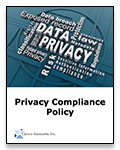Compliance Management Governance Best Practices
 The compliance process needs to be structured and robust enough to deal with all of the changing compliance requirements. To support this, the top 10 best practices are:
The compliance process needs to be structured and robust enough to deal with all of the changing compliance requirements. To support this, the top 10 best practices are:
-
Know the industry and governmental compliance requirements - One individual in the enterprise need to understand the regulations that affect your industry and oversee your internal compliance requirements. If possible this individual is a Chief Compliance Officer.
-
Know the enterprise industry's regulatory environment - There needs to be a clear understanding of the regulatory environment of the enterprise’s specific industry. Not every organization has the personnel or expertise to stay up to date with every piece of legislation and its requirements on them. Someone in the enterprise should formally add these compliance responsibilities to their jobs. Again, this could be the Chief Compliance Officer (CCO).
-
Determine enterprise compliance goals - Question to ask what are the goals and objectives of the compliance management process? The enterprise should identify key results that matter to its various stakeholders. It also means establishing clear metrics to measure how well the compliance program meets those goals and objectives.
- Create effective policies and procedures - The compliance management best practices mean getting all of these expectations and requirements in writing for employees to know and sign off on. And Compliance Management Tool Kit provides that solution to make this process easier and more provable if or when regulators come calling.
- Hold employees and related parties accountable - There need to be consequences if compliance mandates are not followed.
- Conduct regularly scheduled compliance audits - Schedule a CCO, a compliance audit consultant, or even a compliance team to conduct a comprehensive review of all the regulatory compliance mandates the enterprise needs to address. Besides assessing whether or not the enterprise is meeting all these regulations, the auditor should establish a baseline of where the enterprise’s compliance efforts currently stand. For example, determine how many violations the enterprise has had, how much these violations have cost, and if the enterprise has at-risk areas that could potentially be fined.
- Take actions on issues and problems - Capture, log, and categorize noncompliance issues, process non-conformance, and near misses. Implement a corrective/preventive action process based on the importance of issues. Be disciplined in the timely completion, close-out, and documentation of all corrective/preventive actions.
- Build and maintain a comprehensive compliance management solution (electronic and paper) - The enterprise need to ensure that only the most up-to-date and accurate information exists in its compliance management solution.
- Track compliance violations and costs - monitor the costs associated with compliance violations and quantify that non-compliance is having on the enterprise’s bottom line, productivity, level of customer trust, and reputation. Like the audit, tracking violations and costs offer a good way to define the ROI of additional risk mitigation measures.
- Implement comprehensive compliance training - Training on compliance policies and procedures reinforces the behaviors and processes that will be the most effective.
Read On Order Compliance Management Kit Download TOC





